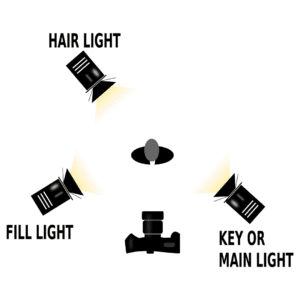In the digital era, creating professional headshots is a necessity. The prevalence of imagery on websites and social media means a poor quality photo will stick out more than anything.
Here are a few tips on how to take better headshot photos.
1. FOCAL LENGTH: This one is probably the easiest technique to implement; choosing the correct lens, focal length, and distance from the subject. Some angles and distances just aren’t flattering on humans (anyone who has accidentally opened the front camera on their phone while holding it knows exactly what we’re talking about). For a portrait-style photo, an 85mm lens is a great choice. Stand about 10 feet away from the subject and hold the camera at the subject’s eye level or slightly above.
2. LIGHTING: Working with proper lighting is critical for all photos, including headshots. A simple-but-effective lighting setup for portraits is called “three point lighting.”
The primary light source is called the “key light.” The key light should hit the 5 planes of the face (1) forehead (2) two cheek bones (4) line down the nose (5) line down the chin. Diffuse and soften this light as much as you can, either by using a softbox, diffuser, or a large light source (such as a window during the day) as your key light. Use the fill light to soften the shadows on the subject’s face opposite the key light, and use the hair light to create light outlines around them and separate the subject from the background and accentuate their jawline.

3. POSING AND EXPRESSION: This is probably the most difficult part of shooting headshot photos. Start out by having the subject turn their body and point their toes toward the key light, then turn their head back toward the camera. Have them tilt their chin down and slightly out.
The next step is to elicit a genuine smile (or other expression if desired) from the subject. Headshots are all about the person’s expression, and that expression needs to be genuine. You don’t want it to seem like the subject is looking at a camera; you want it to seem like they’re looking at another human being.
Avoid telling them to “smile.” That’s the fastest way to get a fake smile and a bad photo. Talk to the subject to help them relax. Talk about your life or theirs. Get them to laugh (but don’t take the photo during the laugh – wait for the laugh to end, and most people will follow a laugh with a natural and genuine smile). The key here is teamwork; you want the subject to know they’re interacting with you and not the camera.
In fact, do your best not to look down at the camera between shots, and don’t talk about adjusting settings or anything like that. Once you draw the subject’s attention to the camera, it can intimidate them and make it more difficult for them to relax.
The right photo can make all the difference, and here at Vervocity, we’ve been shooting headshot photos for years! Contact us today and let’s chat about your professional photography or videography needs.











